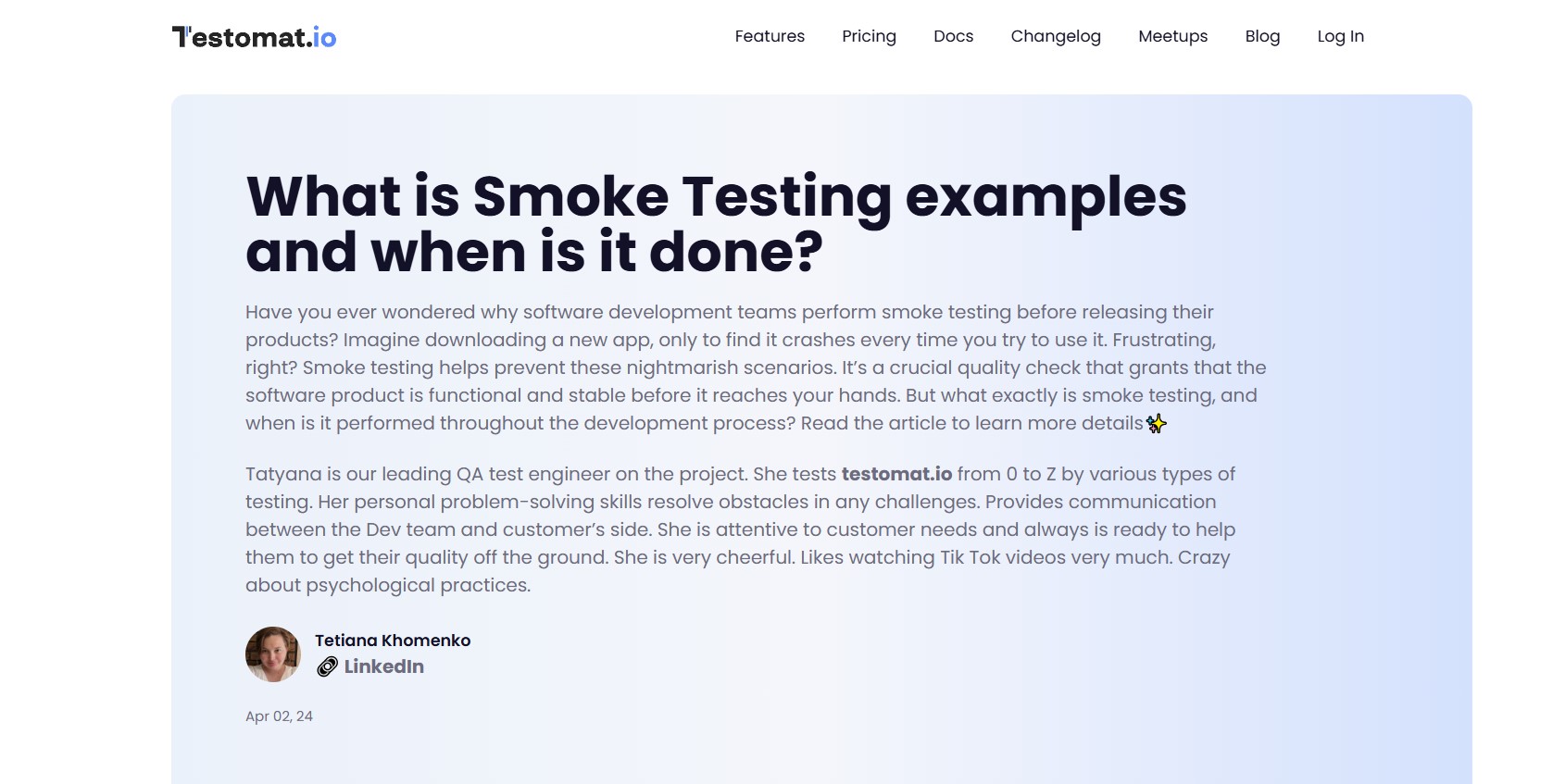Understanding Smoke Testing: Meaning, Importance, and Best Practices

Strong 8k brings an ultra-HD IPTV experience to your living room and your pocket.
In the fast-paced world of software development, ensuring the quality of an application before releasing it to users is crucial. Among the various testing techniques used, smoke testing is one of the most effective ways to check the basic functionality of an application before conducting more in-depth tests. Understanding **smoke testing meaning**, its importance, and when it should be applied can significantly improve your testing strategy and save valuable development time.
In this article, we will delve into the **smoke testing meaning**, the role it plays in the software development lifecycle, how it differs from other testing methods, and best practices for implementing it. Additionally, we will explore how tools like Testomat can streamline the process of managing and executing smoke tests efficiently.
### What is Smoke Testing?
At its core, **smoke testing** refers to a preliminary test to check if the most critical and basic features of an application are functioning properly. The term "smoke test" originates from hardware testing, where a device would be powered on, and if it didn’t catch fire or produce smoke, it was considered to be working. Similarly, in software testing, smoke testing aims to quickly verify that the software build is stable enough to proceed with more extensive testing.
Rather than testing every function of an application, **smoke testing** is a quick way to identify if the core features, such as logging in, navigation, and other key workflows, are functioning as expected. If these features fail, it’s an indication that the software has significant issues, and further testing would be futile until these problems are addressed.
### When Should Smoke Testing Be Done?
**Smoke testing** is typically conducted at the early stages of the development lifecycle, particularly after the initial build is created or when a new version of the software is released. The main goal is to ensure that the build is stable enough to proceed with more rigorous testing processes, such as functional testing or regression testing.
Here are key moments when **smoke testing** should be performed:
1. **After a New Build**: Whenever a new version or build of the application is released, smoke testing should be the first step to check if the build is stable enough for further testing.
2. **Before Regression Testing**: Smoke tests help determine whether the system is in a testable state before regression testing is carried out.
3. **After Bug Fixes or Code Changes**: When critical bugs are fixed or major code changes are made, smoke testing ensures that these changes haven’t broken the basic functionality of the system.
### Smoke Testing vs. Other Testing Methods
While **smoke testing** is a basic test of an application’s functionality, it differs from other testing types in several ways. Here’s a comparison of **smoke testing** with other popular testing techniques:
* **Smoke Testing vs. Sanity Testing**: Both smoke testing and sanity testing are designed to ensure that the software build is stable. However, while smoke testing checks for basic functionality, sanity testing is a more focused test performed when a specific part of the software needs to be verified after changes or bug fixes.
* **Smoke Testing vs. Regression Testing**: Smoke testing is a preliminary test that checks core functionalities, while regression testing involves testing the entire application to ensure that new changes or additions do not introduce new bugs in existing features.
* **Smoke Testing vs. Functional Testing**: Functional testing verifies that the software works according to its specifications, whereas **smoke testing** checks only the basic features to ensure that the application is ready for further testing.
### The Importance of Smoke Testing
Implementing **smoke testing** is critical for several reasons:
1. **Saves Time and Resources**: By catching major issues early in the process, **smoke testing** prevents the waste of time and resources on more extensive testing if the build is fundamentally flawed.
2. **Early Detection of Critical Issues**: Smoke testing helps quickly identify showstopper issues that would prevent further testing or the software from functioning properly.
3. **Ensures Testability**: It verifies that the application is stable enough for deeper and more comprehensive testing to take place, helping the QA team decide if it’s worthwhile to continue with other testing methods.
4. **Improves Software Quality**: Frequent smoke tests during development iterations ensure that the quality of the application is maintained throughout the process.
### Best Practices for Smoke Testing
To maximize the effectiveness of **smoke testing**, it’s important to follow best practices and adopt a structured approach. Here are some recommended practices:
1. **Identify Critical Features**: Focus on the core functionality that defines the user experience. The features to test should include logging in, navigating between pages, and performing basic tasks such as submitting forms or accessing key data.
2. **Automate Smoke Tests**: Since **smoke testing** is often repeated after every build, automating these tests can save significant time and effort. Tools like Testomat provide automation features that simplify the creation, execution, and monitoring of smoke tests.
3. **Keep the Tests Simple**: The goal of smoke testing is not to test everything but to verify basic operations. Keep the tests concise, focusing on the main workflows that determine if the application is stable.
4. **Run Smoke Tests Early**: Smoke tests should be run immediately after the software build is ready. This ensures that the development team can fix any major issues before moving forward with further testing.
5. **Document Results**: Keep a record of smoke testing results to track the stability of different builds and ensure transparency in the testing process.
### Tools for Effective Smoke Testing
To streamline the process of **smoke testing** and make it more efficient, consider using a variety of tools. Here are some of the top tools used in smoke testing:
1. **Testomat.io**: Testomat is a versatile test management tool that supports both manual and automated smoke testing. It allows teams to organize their test cases, track results, and collaborate more effectively.
2. **Selenium**: Selenium is a popular tool for automating web applications, and it can be used to automate smoke tests for web-based applications, saving time and ensuring consistency.
3. **JUnit**: JUnit is a widely used testing framework for Java applications. It can be easily integrated with other tools to automate smoke tests for backend systems.
4. **TestComplete**: This tool allows for automated smoke testing and ensures that your software meets its basic functional requirements before more complex testing begins.
5. **Cucumber**: Cucumber is a tool used for behavior-driven development (BDD), and it allows testers to write clear, executable specifications for smoke tests.
By leveraging tools like **Testomat.io**, teams can optimize their **smoke testing** processes and focus on what really matters: ensuring that the application functions at a fundamental level.
### Conclusion
**Smoke testing** is an essential part of the software development lifecycle. Understanding **smoke testing meaning**, knowing when to apply it, and following best practices can significantly improve the quality of your application while saving time and resources. By identifying critical features, automating tests, and using the right tools like **Testomat.io**, development teams can ensure that their software is stable enough to proceed with further testing, ultimately delivering a higher-quality product.
For a detailed guide on smoke testing, visit [**smoke testing meaning**](https://testomat.io/blog/what-is-smoke-testing-in-examples-and-when-is-it-done/) to dive deeper into its importance and best practices.
Note: IndiBlogHub features both user-submitted and editorial content. We do not verify third-party contributions. Read our Disclaimer and Privacy Policyfor details.


